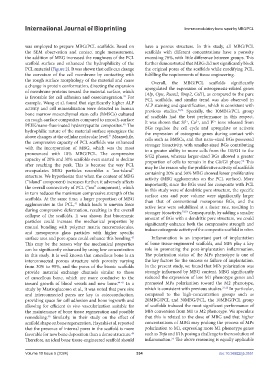Page 342 - IJB-10-5
P. 342
International Journal of Bioprinting Immunomodulatory bone repair by MBG/PCL
was employed to prepare MBG/PCL scaffolds. Based on have a porous structure. In this study, all MBG/PCL
the SEM observation and contact angle measurement, scaffolds with different concentrations have a porosity
the addition of MBG increased the roughness of the PCL exceeding 70%, with little difference between groups. This
scaffold surface and enhanced the hydrophilicity of the further demonstrated that MBG did not significantly block
PCL material (Figure 2). It was shown that cells can change the original pores of the scaffolds while modifying PCL,
the curvature of the cell membrane by contacting with fulfilling the requirements of tissue engineering.
the rough surface morphology of the material and cause Overall, the MBG/PCL scaffolds significantly
a change in protein conformation, directing the expansion upregulated the expression of osteogenesis-related genes
of membrane proteins toward the material surface, which (Alp, Opn, Runx2, Bmp2, Col1), as compared to the pure
is favorable for cell adhesion and osseointegration. For PCL scaffolds, and similar trend was also observed in
39
example, Wang et al. found that significantly higher ALP ALP staining and quantification, which is consistent with
activity and cell mineralization were detected in human previous studies. 50,51 Specially, the 10MBG/PCL group
bone marrow mesenchymal stem cells (hMSCs) cultured of scaffolds had the best performance in this respect.
on rough-surface composites compared to smooth-surface It was shown that Si , Ca , and P ions released from
5+
2+
2+
PEEK/nano-fluorinated hydroxyapatite composites. The BGs regulate the cell cycle and upregulate or activate
40
hydrophilic nature of the material surface synergizes the the expression of osteogenic genes during contact with
above changes at the cellular molecular level. Meanwhile, cells such as BMSCs, and that nano-sized BGs possessed
41
the compressive capacity of PCL scaffolds was enhanced stronger bioactivity, with smaller-sized BGs contributing
with the incorporation of MBG, which was the most to a greater ability to move cells from the G0/G1 to the
pronounced with 10% MBG/PCL. The compressive S/G2 phases, whereas larger-sized BGs allowed a greater
capacity of 20% and 30% scaffolds even started to decline proportion of cells to remain in the G0/G1 phase. This
52
after reaching the peak. This is because the way PCL may be the reason why the proliferative activity of scaffolds
encapsulates MBG particles resembles a “sea-island” containing 20% and 30% MBG showed lower proliferative
structure. We hypothesize that when the content of MBG activity (MBG agglomerates on the PCL surface). More
(“island” component) increases further, it adversely affects importantly, since the BGs used for composite with PCL
the overall connectivity of PCL (“sea” component), which in this study were of dendritic pore structure, the specific
in turn reduces the maximum compressive strength of the surface area and pore volume were significantly larger
scaffolds. At the same time, a larger proportion of MBG than that of conventional mesoporous BGs, and the
agglomerates in the PCL, which leads to uneven force active ions were solubilized at a faster rate, resulting in
42
during compressive deformation, resulting in the overall stronger bioactivity. 53,54 Consequently, by adding a smaller
collapse of the scaffolds. It was shown that bioceramic amount of BGs with a dendritic pore structure, we could
particles could increase the mechanical properties by significantly enhance both the compressive strength and
mutual bonding with polymer matrix macromolecules, induce osteogenic activity of the composite scaffold in vitro.
and mesoporous glass particles with higher specific
surface area and pore space could enhance this bonding. Inflammation is an important part of implantation
43
This may be the reason why the mechanical properties of bone tissue-engineered scaffolds, and MPs play a key
can be significantly enhanced by using low concentration role in promoting the post-implantation inflammation.
in this study. It is well known that cancellous bone is an The polarization status of the MPs phenotype is one of
interconnected porous structure with porosity varying the key factors for the success or failure of implantation.
from 30% to 95%, and the pores of the bionic scaffolds In the present study, we found that MPs polarization was
provide material exchange channels similar to those strongly influenced by MBG content. MBG significantly
of cancellous bone, which are more conducive to the reduced the expression of low M1 phenotype genes and
inward growth of blood vessels and new bone. 44-47 In a promoted MPs polarization toward the M2 phenotype,
study by Mastrogiacomo et al., it was noted that pore size which is consistent with previous studies. 21,22 In particular,
and interconnected pores are key to osteoconduction, compared to the high-concentration groups such as
providing space for cell adhesion and bone ingrowth and 20MBG/PCL and 30MBG/PCL, the 10MBG/PCL group
allowing for efficient in vivo vascularization suitable for of scaffolds induced the most significant performance of
the maintenance of bone tissue regeneration and possible MPs conversion from M1 to M2 phenotype. We speculate
remodeling. Similarly, in their study on the effect of that this is related to the dose of MBG and that higher
48
scaffold shape on bone regeneration, Hayashi et al. reported concentrations of MBG may prolong the process of MPs
that the presence of internal pores in the scaffold is more polarization to M1, expressing more M1 phenotype genes
favorable for new bone deposition than a dense structure. such as Tnfa and Il1b, posing a challenge to the resolution of
49
Therefore, an ideal bone tissue-engineered scaffold should inflammation. The above reasoning is equally applicable
55
Volume 10 Issue 5 (2024) 334 doi: 10.36922/ijb.3551

